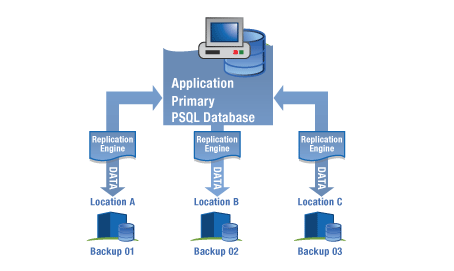Login Form
Poly-Asia - Shopping cart
Cart empty
Data Replication Technology
Pervasive DataExchange leverages sophisticated database replication technology to ensure your mission-critical data is always where you need it when you need it.
DataExchange captures and shares changes from one Pervasive PSQL database to another in a DataExchange replication network. Each database is augmented with DataExchange, which adds two software components to a Pervasive PSQL database, the Replication Event Handler and the Replication Engine.
- The Replication Event Handler (REH) plugs directly into the Pervasive PSQL database engine. Specifically, the REH is a set of DLLs that operate within the database engine, so if the database is running, the replication event handler is also running. The database engine activates the REH when there is a change event (insert, update, delete). The REH then makes note of the event in one of its private control tables.
- The Replication Engine is a separate process that performs the actual replication task. It reads the control tables to determine what records have changed since the last replication session. It then groups these changes into packets and shares them with the other replication engines participating in a DataExchange network. These other engines then apply the updates to their own databases. The replication process occurs either continuously, at scheduled intervals, or on demand. The replication engine does not require constant network connectivity, so DataExchange is suitable for scenarios with intermittent connectivity like remote users with dialup connections.
DataExchange Real-Time Backup
DataExchange Data Synchronization
The DataExchange engine has the following advanced capabilities:
- Replication normally occurs at the transactional level, so data definition files (DDFs) are not required.
- Update packets are encrypted using a 128-bit key. This enhances security by eliminating the possibility of unauthorized viewing of the database changes.
- Conflicts are detected and resolved. Conflicts occur when the same record in two different databases is edited at the same time. In most applications, data conflicts are rare or nonexistent. In cases where data conflicts do occur, there are default and user definable resolution rules.
- Network topology is flexible. While most DataExchange networks include only two databases replicating back and forth, multiple database scenarios and organizations are possible. Supported topologies include ring, hub and spoke, peer-to-peer, and hierarchical.
In addition, DataExchange includes a full suite of design, maintenance and monitoring tools.


